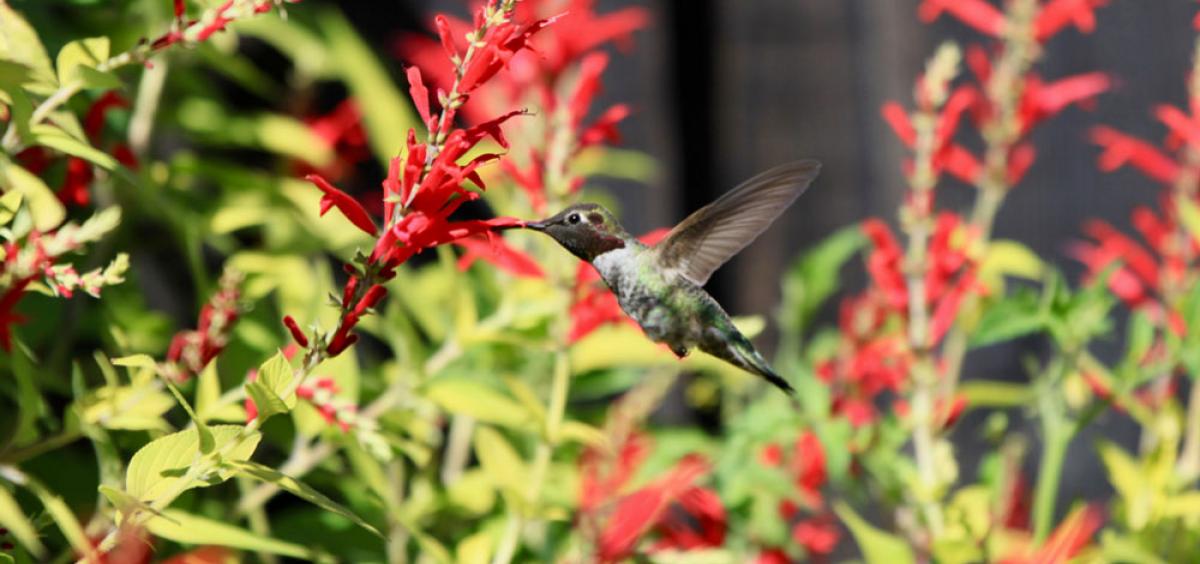CORVALLIS – Pacific Northwest gardeners are faced with the pleasant dilemma of choosing from an encyclopedia-length list of perennials that grow in our friendly climate, and many of those thrive in low-water situations.
To transition the landscape to water-wise plants, start with a small area such as a parking strip or an already-dry area of the garden, said Gail Langellotto, a horticulturist with Oregon State University’s Extension Service. Conversely, keep high-water plants in areas naturally moist or that have well-amended, claylike soils that tend to hold water longer.
Even low-water plants need regular irrigation for the first two years while roots get established, she said. After that, a good soak every two weeks, less in milder weather, is sufficient.
Before planting, consider installing a drip system or soaker hoses, which direct water most efficiently. If using a sprinkler, Langellotto said it’s a good idea to periodically check to make sure they’re delivering the correct amount of water to the proper areas. Use a rain gauge or other container to measure.
“A lot of drought-tolerant plants have a double benefit,” Langellotto said. “They’re great for water conservation, but also for attracting all kinds of bees.”
To get ideas of how to garden with water-wise plants, visit one of the OSU Master Gardener demonstration gardens around the state. To find the closest, call a Master Gardener hotline or your county Extension office.
Here are Langellotto’s recommendations for drought-tolerant perennials:
-
Bishop’s hat (Epimedium): Typically, it’s difficult to find an exciting plant for dry shade situations, but this evergreen perennial fits the bill. The plants come in various sizes from very short ground covers to 2-foot mounds. Heart-shaped leaves set off the dainty flowers that look like tiny, upside-down bishops’ hats, hence the name. Hardy to Zone 5.
-
Catmint (Nepeta): A plant consistently rated in the top three for attracting bees, catmint is just as beloved by people. And why not? This free-blooming beauty cranks out lavender-blue flowers on upright, 2-foot stems from spring until fall. Hardy to Zone 4.
-
Hellebore (Helleborus): A good candidate for the difficult situation of dry shade, though this evergreen perennial will also enjoy some morning sun. Starts blooming very early in spring before other perennials have even thought about showing their flowers. The blooms traditionally were greenish-white, but now come in purple, rose, yellow, some lined, spotted or speckled with darker colors. Most recently doubles have hit the market. Hardy to Zone 6.
-
Hummingbird mint (Agastache): Flowers climb up spires that average anywhere from 18 inches to 3 feet and appear throughout the summer right through to the first frost. Deer are usually uninterested in the fragrant foliage, but pollinators and hummingbirds can’t resist the flowers that come in an impressive array of colors, including lavender, pink, rose, orange and white. Hardy to Zone 5.
-
Oregano ‘Kent Beauty’ (Origanum): A great choice for cascading over a wall or in a pot, this ornamental oregano takes full, hot sun with aplomb. White blooms tinged with purple look like rose-and-cream hop flowers on a silvery blue plant that only gets 6 inches tall. Hardy to Zone 4.
-
Penstemon hybrids: Draw hummingbirds and the admiration of visitors with the showy, long-blooming flowers of this semi-evergreen perennial that grows to 2 to 4 feet tall. Hummingbirds and bees cannot pass up the spikes of blooms in shades of purple, red and pink, often with white throats. Needs very good drainage. Most hardy to Zone 7.
-
Pineapple sage (Salvia elegans): Pineapple sage comes by its name honestly with unmistakably scented foliage. A handy plant for the pure red flowers that bloom in late summer and fall when many other perennials have finished. It also provides some added sustenance for hummingbirds. Grows 3 to 4 feet tall. Hardy to Zone 8.
-
Sea holly (Eryngium amethystinum): If you’re looking for drama in the garden, try this perennial with spiky, thistle-like, ice blue flowers that stand up to about 2 feet. Deer tend to stay away from sea holly, which pairs well with small ornamental grasses. Great as a cut flower. Hardy to Zone 3.
-
Sedum (Sedum ‘Autumn Joy’): A stalwart, fall-blooming perennial with dense, dome-shaped clusters of flowers that start out pink, darken to rose and then to russet red. Succulent foliage grows about 2 feet tall and wide. Attracts bees and butterflies. Don’t amend the soil or the plant can get floppy. Hardy to Zone 4.
-
Yarrow (Achillea millefolium): Disc-shaped white flowers from June to September are like runways for bees and butterflies that land on a regular basis. Soft, ferny foliage grows 2 feet tall and wide. Hybrids are available most commonly in yellow and pink. Hardy to Zone 3.
